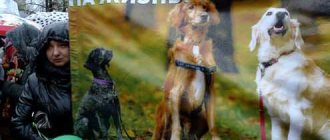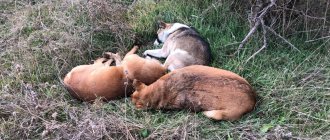The killing of an animal alone cannot serve as a sign of a crime, otherwise all cases of slaughter of livestock or poultry would have to be included in it. Which explains the number of clauses present in Art. 245 of the Criminal Code on cruelty committed against animals. The absence of at least one of the conditions leads to the impossibility of punishing the violator. As a result, many cases of abuse of pets remain without retribution. This circumstance indicates the shortcomings of the existing regulatory act.
Corpus delicti
Inhumane treatment of animals is qualified under Article 245 of the Criminal Code.
Object of the unlawful act
The crime violates the moral principles of society, which preach humane treatment of living beings. It encroaches on the mental health of the younger generation and affects the worst aspects of the personality, awakening a pathological tendency to violence. Unlawful actions directed against an animal that has an owner also affect property rights.
Subject of violation
Criminal liability is provided for cruel treatment not only of domestic animals, but also of wild animals.
Objective side
As the article points out, cruelty to animals will only be recognized as a crime if each of the following conditions is present:
- The action directed against the animal was accompanied by cruelty.
- Beatings and bullying led to one of the consequences:
- death of an animal;
- injuring him.
- hooligan urges;
Abusive relationship concept
Cruelty to animals can be expressed:
- torture;
- beating;
- strangulation;
- conducting experiments;
- deprivation of food, water;
- placement in unbearable conditions;
- restriction of movement;
- other actions.
Subject of the crime
Criminal liability for cruelty to animals threatens legally capable persons who have reached the age of sixteen.
Subjective side
The crime is characterized by the presence of:
- Direct intention, when the perpetrator is aware of the actions being performed and desires the death of the animal or injury to it.
- Indirect intent, in which the goal is to torture the animal itself, and the consequences of such actions are not of interest to the offender.
more information about direct and indirect intent in criminal law.
What is needed to reduce cruelty to animals?
Director of the Vita Foundation Irina Novozhilova says that the organization has been operating for 27 years and during this time the situation with cruelty to animals and the investigation of such crimes has not changed. The social activist is sure that one of the main reasons for this stagnation is the ineffective system for dealing with stray animals in Russia.
In Russia, according to the Ministry of Natural Resources, there are 501 shelters. However, regional ministries say that 785 more shelters are needed to house all the stray animals. The most prepared to accommodate homeless animals are Moscow - 13 thousand places - and the Moscow region - 9 thousand places.
At the same time, animal rights activists from the Animal Welfare Association have calculated that one shelter can accommodate a maximum of 150-250 dogs. It turns out that even if 785 more shelters are built in the regions, this will not help accommodate all homeless animals. At least half of them will remain on the street, animal rights activists are sure.
“Stray animals appear as a problem in those countries where the state does not take control over the breeding of companion animals - dogs and cats,” says Irina Novozhilova. — The state should control two types of breeders: those who reproduce for the sake of business - this is the class of breeders - and those who reproduce out of thoughtlessness - these are ordinary citizens who simply do not sterilize their animals and get offspring. These two categories must be very tightly controlled. If we turn off the breeding tap in the country, conditions will be created that will make animals disappear from the streets in a few years.”
Responsibility for cruelty committed against animals
The Code of Administrative Offenses of the Russian Federation does not provide for punishment for savage attitude towards representatives of the animal world. However, the criminal can be prosecuted:
- For damaging someone else's property.
- According to the regional Code of Administrative Offences.
- According to Art. 245 of the Criminal Code.
Damage to someone else's property
Article 137 of the Civil Code of the Russian Federation presupposes the application to animals of the general rules that apply to property. Thus, causing harm to someone else's animal can be classified as intentional destruction or damage to property. Depending on the amount of damage caused, the perpetrator is brought to administrative or criminal liability. This method can be resorted to if the crime cannot be qualified under Art. 245 of the Criminal Code of the Russian Federation for cruelty to animals.
Administrative punishment
Additionally,
Article 245 of the Criminal Code of the Russian Federation classifies only those crimes that were committed in the presence of minors or using sadistic methods. As an example when these conditions were not met, we can cite the activities of dog hunters who do not torture animals, but poison them with food containing poison. In this case, the court, along with Article 245, may also apply related ones, in particular Art. 167 of the Criminal Code (deliberate destruction or damage to property) and Article 213 of the Criminal Code (hooliganism).
If the damage is considered insignificant, an amount of 300 to 500 rubles is collected from the violator. (Article 7.17 of the Administrative Code). And, since a pet cannot be considered a valuable property, the punishment for its tormentor can be considered almost symbolic.
Criminal liability
Significant damage caused to someone else's property is punishable (Article 167 of the Criminal Code):
- A fine in the amount of:
- up to 40,000 rubles;
- earnings received in 3 months.
If the act was committed out of hooligan motives, the perpetrator is sentenced to:
- forced labor for a period of up to 5 years;
- imprisonment for up to 5 years.
More information about property damage in criminal law can be found in the article https://lexconsult.online/6613-otvetstvennost-za-povrezhdenie-imushhestva.
Find out from the video about the punishment provided for in Article 245 of the Criminal Code of the Russian Federation
Regional regulations
The local Code of Administrative Offenses of some cities of the Russian Federation provides for punishment for cruelty towards our smaller brothers.
Moscow
As prescribed by the local law on cruelty to animals, the violator pays a fine of 4,000 to 5,000 rubles. for committing actions that led to the death or injury of an animal.
Saint Petersburg
Persons involved in the death of an animal resulting from the following actions are brought to administrative liability:
- transportation in conditions harmful to health;
- intentional deprivation of food and water;
- savage experiment.
Violation is punishable by a fine of up to:
- 5000 rub. for FL.
- 100,000 rub. for YUL.
It is worth noting: after witnessing the abuse of an animal, you should not organize lynching of the flayer. It is necessary to contact law enforcement authorities by writing a corresponding statement. Evidence of cruelty to animals is .
Criminal Code
Art. 245 of the Criminal Code contains 2 points.
Paragraph 1
The perpetrator is subject to:
- A fine in the amount of:
- up to 80,000 rub.;
- salaries for 6 months or less.
Point 2
The punishment becomes more severe if the crime is committed:
- several persons;
- by prior agreement;
- organized group.
In this case, the following are assigned:
- Fine in the amount:
- RUB 100,000–300,000;
- income for 1–2 years
It is worth noting: actual sentences for cruelty to animals in Russia are rather a rare exception than the rule. Most cases that do end up in court result in fines or probation. Find out what probation means.
Animal laws
At the end of May 2015, the Prikubansky District Court of Krasnodar dropped the criminal case against 32-year-old Alexey Kiselev, who hung a jackal and a raccoon under a parking lot canopy. The incident occurred on Christmas: Kiselev caught the animals near his dacha near Primorsko-Akhtarsk, after which he decided to skin them. Leaving the animals under the supervision of his friend in the parking lot, Kiselev went to celebrate a Christian holiday. The jackal, hanging for several hours in 12-degree frost, died before passers-by found the animals. The raccoon, which local residents brought to the veterinarian, also could not be saved. Kiselev was granted amnesty.
The son of a judge from the Yamalo-Nenets Autonomous Okrug, Elisey Vladimirov, who shot a squirrel with an air pistol on Elagin Island in St. Petersburg, was also included in the amnesty. At the trial, Vladimirov explained that the animal itself attacked him, grabbing his leg.
Until now, law enforcement agencies have not opened a case of cruelty to animals against employees of a traveling circus who were carrying a bear cub around Anapa on a hot car hood. According to eyewitnesses, the bear cub was kept muzzled and chained. The animal tried to climb into the car window, but two men sitting inside pushed it back out. Employees of the Azov-Black Sea Interdistrict Environmental Prosecutor's Office conducted a pre-investigation check, after which they seized the bear and transferred it to the local Balu Zoo.
According to Article 137 of the Civil Code, general rules on property apply to animals “to the extent that the law or other legal acts do not provide otherwise.” At the same time, the article stipulates that “in the exercise of rights, cruelty to animals that is contrary to the principles of humanity is not permitted.” However, in Russia there is no document defining the humane or cruel treatment of domestic or wild animals kept in captivity.
In 1999, the State Duma, in all three readings, adopted the draft law “On the Protection of Animals from Cruelty,” designed to strengthen the legal status of animals, as well as the morality and humanity of society. The law was approved by the Federation Council, however, at the beginning of 2000, Vladimir Putin, who was then acting head of state, rejected the bill for some reason. In 2008, the document was removed from parliamentary consideration.
Another bill, called “On the Responsible Treatment of Animals,” has been under consideration by the State Duma for almost five years. In 2011, it even passed the first reading, but since Maxim Shingarkin, State Duma deputy from the LDPR and deputy chairman of the parliamentary committee on natural resources, environmental management and ecology, was appointed head of the working group of the relevant committee, consideration of the bill was suspended.
The bill, which was never adopted, requires that animals be treated “as sentient beings capable of experiencing fear and pain”; the person who takes responsibility for the animal must satisfy the pet’s needs - physiological, nutritional and behavioral. The document clarifies that animals are protected by law from cruelty, suffering and cruel killing. Among other things, the draft prohibits the promotion of cruelty to animals. It also stipulates a ban on the shooting of stray animals - after catching a stray animal, it should be sterilized and then placed in a shelter or returned to its original habitat.
Shingarkin himself explained that the bill, designed to protect animals from cruelty, cannot currently be finalized due to “legal subtleties.” Due to homeless animals, too much responsibility will fall on the shoulders of public utilities and local authorities, he believes.
“Dogs and cats are not residents of Russia. According to the civil code, animals are listed as property. It can be ownerless, for example, rats running around garbage dumps can be city rats. Municipalities are responsible for feeding, protecting and ensuring other security measures,” the deputy explained his point of view.
Possible changes in legislation
The article of the Criminal Code of the Russian Federation on cruelty to animals in its current form is not satisfactory from the point of view of animal defenders, representatives of A Just Russia and other government officials. The President of the Russian Federation also supports the initiative to change legislation towards tougher punishment.
The corresponding bill, developed by State Duma deputy O. Lebedev, was proposed back in 2011. However, its approval was prevented by an incredible number of amendments and comments, exceeding 2000. Consideration of proposals and introduction of amendments took quite a long time and continues to this day.
A real case from judicial practice is the punishment of flayers. Details - in the video
Practical examples
The trespassers used neighbors' cats as shooting targets, causing them various injuries. The elements of the crime are obvious, so the owner of the cats has the right to contact the police. However, the neighbors were not caught by her at the time of committing malicious acts, which requires an investigation and identification of the perpetrators.
A village resident had been observing the misbehavior of a teenager throwing stones and shooting an air pistol at neighbors' cats for some time. In the presence of injuries, wounds and the expected death of animals, which is indicated by a decrease in their numbers. In the absence of other eyewitnesses to what is happening, it is advisable to record the teenager’s actions on video, and then provide the evidence obtained to the police. Due to his age, the violator will not be held accountable, but may be registered with the PDN.
Want more information? Ask questions in the comments to the article










